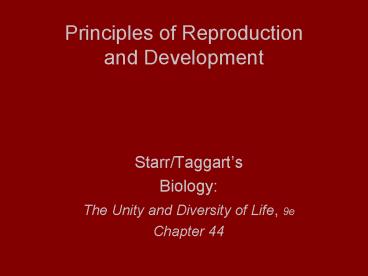Principles of Reproduction and Development - PowerPoint PPT Presentation
1 / 15
Title:
Principles of Reproduction and Development
Description:
ectoderm. neural tube. gut cavity. notochord. Within the gastrula, one can see ... ectoderm. What comes ... Ectoderm and mesoderm interaction in a chick ... – PowerPoint PPT presentation
Number of Views:443
Avg rating:3.0/5.0
Title: Principles of Reproduction and Development
1
Principles of Reproduction and Development
- Starr/Taggarts
- Biology
- The Unity and Diversity of Life, 9e
- Chapter 44
2
Review
- What is fertilization?
- What is the relationship between the egg, sperm
and zygote?
3
Embryology
- What is embryology?
- The study of early development in organisms from
fertilization on through each successive stage.
4
Stages of Embryonic Development
Gamete Formation
frog egg
Fertilization
frog sperm
Cleavage
Gastrulation
midsectional views
Organ Formation
top view
side view
Growth, Tissue Specialization
Fig. 44.3, p. 766
5
Stages of Embryonic Development
Gamete Formation
frog egg
Fertilization
frog sperm
- Cleavage is the process of rapid cell divisions
that leads the zygote to form a ball of cells
called a blastula
Cleavage
Gastrulation
midsectional views
Organ Formation
top view
side view
Growth, Tissue Specialization
Fig. 44.3, p. 766
6
Cleavage Patterns
Early protostome embryo. Its four cells are
undergoing cleavages oblique to the original body
axis
Early deuterostome embryo. Its four cells are
undergoing cleavages parallel with and
perpendicular to the original body axis
In-text, p. 436
7
animal pole
gray crescent
vegetal pole
Fig. 44.4a, p. 767
8
dorsal lip
blastocoel
dorsal lip (site of inward migration)
archenteron
Fig. 44.4b, p. 767
9
Gamete Formation
frog egg
Stages of Embryonic Development
Fertilization
frog sperm
The blastula leads to the gastrula through
gastrulation which involves cell divisions, cell
migrations and cell rearrangements
Cleavage
Gastrulation
midsectional views
Organ Formation
top view
side view
Growth, Tissue Specialization
Fig. 44.3, p. 766
10
Cell Differentiation
- Activation of genes and proteins
- Cells migrate to new positions
- Formation of primary tissue layers
11
neural plate
ectoderm
neural tube
endoderm
yolk plug
mesoderm
gut cavity
ectoderm
notochord
Within the gastrula, one can see the germ layers!
Fig. 44.4c, p. 767
12
Primary Tissues
- Ectoderm
- Nervous system
- Integument
- Endoderm
- Gut inner lining and
organs - Mesoderm
- Muscle and skeleton
- Circulatory, reproductive, and excretory organs
- Connective tissue
13
What comes after gastrulation?
- Determination progressive restriction of
developmental potential causing the possible fate
of each cell to become more limited as the embryo
develops - Differentiation
- Controlled by gene expression
- It is the structural and functional divergence of
cells as they become specialized during
development - Induction ability of one group of embryonic
cells to influence the development of another
group of cells
14
Embryonic Induction
- Embryonic cells
- Specialized cells and tissues
Ectoderm and mesoderm interaction in a chick wing
15
Neurulation
- Creates neural tube, neural crest, true epidermis
- Neural tube formation































